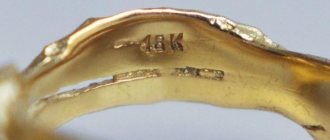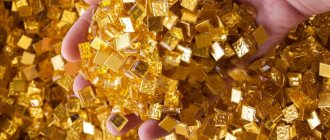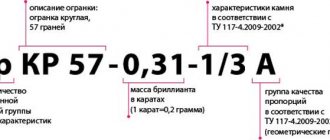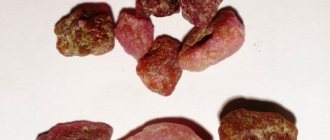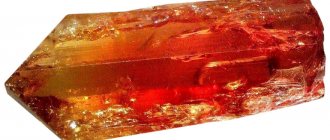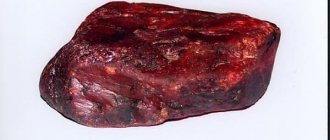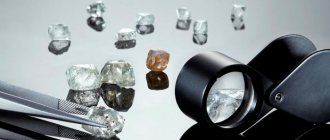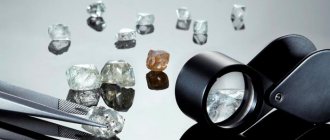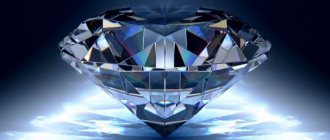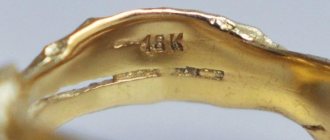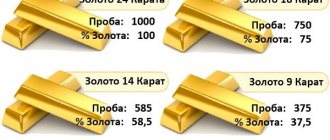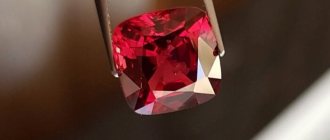Price for synthetic analogues
Industrial production of artificial rubies is established in the USA, Great Britain, France, Switzerland and Germany.
The stone is obtained from molten corundum. The resulting product is initially transparent. Additives give it any desired color.
Despite the fact that an artificial ruby looks better than a natural one, it costs half as much.
Most commercially available jewelry contains synthetic stones.
How many grams in one carat
When assessing the purity of a precious metal, the consonant term karat is used instead of carat. Abbreviated as "K". The amount of precious metal is determined by converting gold carats to grams based on thousandths of a metric sample.
The formula is written as “a/x = 1000”, where x means the metric standard, and a means the carat system.
The ratio of gold per kilogram of alloy after conversion to grams:
- 375 g - 9 K;
- 500 g - 12 K;
- 900 g - 21.6 K;
- 585 g - 14 K;
- 916 g - 22 K;
- 958 g - 23 K;
- 990 g - 24 K.
The jewelry carat weight for gems is 200 mg or 0.2 g (1 g is 5 times heavier than 1 carat). It is written in whole numbers with the obligatory indication of thousandths after the decimal point. That is, in the price tag a crystal weighing 1 ct is marked with the number 1,000 ct, at 1.55 ct they write 1,550 ct, at 0.5 ct - 0,500 ct.
Ruby
Ruby is a variety of the mineral corundum with a characteristic bright red color. Color: red in various shades Hardness: 9 Density: 3.97 - 4.05
Ruby got its name from its red color (Latin ruber - red). It was not until 1800 that it was discovered that ruby and sapphire were varieties of the mineral corundum. Before this, both red spinel and garnet were called ruby. The main chromophore in ruby is chromium, while iron gives brownish tints. The color of rubies varies both from different deposits and within one deposit, so it is impossible to judge the place of origin of a ruby by the shade of a ruby. The coloring is often distributed unevenly: in spots or stripes. Rough stones have a dull or greasy shine, but a cut ruby sparkles almost like a diamond.
In terms of hardness, ruby, like corundum in general, is second only to diamond, although it is 140 times softer. At the same time, ruby is 7 times harder than topaz, the next reference mineral on the Mohs scale.
Inclusions often found in rubies indicate their natural origin. The nature of the inclusions (minerals, channels or other cavities) can indicate a ruby deposit. Inclusions of rutile needles give the stone either a delicate silky sheen, or - when properly polished by the cabochon - a cat's eye effect, or reveal the highly prized asterism - the figure of a six-pointed star, sliding along the surface of the cabochon when it is turned. Main deposits: Burma, Sri Lanka, Thailand, India, Kampuchea, Vietnam, Tanzania, Australia.
The classic cut for a ruby, as for a sapphire, is oval with 57 facets (Ov-57).
Often, for stones that are not completely transparent or opaque, as well as stones with a star effect (asterism), a form of processing is used - cabochon. In relation to the Ov-57 cut, all other cut forms for rubies can be considered fancy.
Expert evaluation of rubies and sapphires.
The main quality indicators that characterize rubies and sapphires are weight, color, clarity and quality of cut. The designation of the characteristics of rubies and sapphires at the moment in Russia can be found in accordance with TU 9645-002-45866412-01 “Natural processed rubies (faceted inserts)” and TU 9645-001-45866412-01 “Natural processed sapphires (faceted inserts)” .
Color group evaluation.
| Color group | Hue |
| 1 | Bright red |
| 2 | Medium red and normal red |
| 3 | Light red |
Cleanliness assessment.
| Cleanliness groups | Faceted | Cabochons |
| 1 | Clean and with minor defects in the form of rare cracks, stripes, and pinpoint inclusions in various areas of the stone. They have shine. | With defects in the form of cracks, stripes, inclusions with areas of cloudiness in various areas of the stone, which have partially lost their shine and play. |
| 2 | With small defects in the form of cracks, stripes in combination with point inclusions of other minerals, forming condensations or a network in certain zones of the stone. Have shine | With large defects in the form of a dense network of cracks, stripes, inclusions with zones of turbidity in the volume of the stone. Translucent and opaque, partially lost shine and play. |
| 3 | With defects in the form of cracks, stripes, pinpoint inclusions of other minerals located throughout the stone, with areas of cloudiness in certain areas of the stone that have partially lost their luster. | — |
Sapphire as another diamond competitor
Sapphire, like ruby, is a variety of the corundum family. But, unlike ruby, it is not so rare, it has many deposits, and is found at a relatively shallow depth.
Although this variety of deep blue mineral is common, sapphires from several deposits are most valued for their quality and beauty:
- Kashmir deposit. The most valuable sapphires are mined in the Indian state of Kashmir. Crystal mining has been going on in these lands for more than two hundred years. Stones quarried in Kashmir are characterized by a deep blue color with a violet or purple tint.
- Deposits of Sri Lanka. In Ceylon, two types of gems are mined, which are in great demand, along with Indian ones. The first type of crystal is called Padparadscha and has a reflection of pink and orange hues. And in a deposit near the city of Ratnapura, extremely rare sapphires with a blue glow are mined, which have received the secret name “Ceylon color”.
- Nowadays, the largest sapphires are mined in Thai deposits. At one time, it was here that the largest precious gem on the planet was found - a 958-carat sapphire. Thai stones are characterized by dark blue and dark green shades, while there are unique chameleon stones that shine in different shades, depending on the angle of the light rays.
Top 5 large diamonds
The number of crystals weighing 20 carats or more is so small that they are sold only through auction and often even have their own names. One of these stones is the Cullinan crystal. Its solid weight was more than 3,000 carats. It was subsequently broken into 105 pieces of varying sizes.
The pear-shaped diamond, weighing just over 110 carats, was mined in 2010 and was named “Drop of the Sun.” Its cost reaches 15 million dollars.
The Charles Noir diamond originally weighed 421 carats. After processing, it was reduced to 88. The characteristic features of this stone are its black color and the maximum insurance amount (about 37 million dollars).
Largest uncut ruby
Raja Ratna, or “King of Gems,” has a record size. The weight of the crystal is 2475 carats or 459 grams! Perhaps the only legendary jewel in the world that did not belong to a royal person or a billionaire, but to a modest Indian lawyer, which he received as an inheritance. This is the largest ruby in the world. The stone is not cut, only polished. It has many defects, and processing can ruin the crystal structure.
It happens!
Raja Ratna is a legendary jewel inherited by a humble Indian lawyer.
Another giant red corundum is the Hixon Ruby, weighing 196.1 carats. Experts call it the perfect raw crystal. Named after the owner, who donated it to the Los Angeles Museum of Natural History in 1978.
There is information online about red corundum weighing 440 carats found in Greenland.
What determines the value of a ruby?
Types of rubies
- Deposit and color of the stone. The most expensive rubies are “the color of pigeon blood”; they are scarlet and rich. Rubies with pink or purple hues will be cheaper. Burmese stones are most valued, stones from Mozambique are a little less valuable. Rubies from India, Vietnam and Thailand are considered cheaper. Only a specialist can determine the country of origin of a ruby.
- Purity of the stone. Cracks, foreign inclusions, and cloudiness negatively affect the price of the stone. But if a ruby contains natural inclusions of rutile, it will cost more. Small needles of rutile in certain lighting form a star-shaped effect.
- Mineral weight. Large rubies are practically never found in nature. Therefore, the price of a stone per carat will increase in proportion to its weight.
- The cut of a finished ruby affects the revelation of its radiance and natural brilliance; you can recognize an expensive stone by its quality cut.
- Natural or artificial origin of the stone. A lab-grown stone is much cheaper than a naturally occurring mineral.
- Exchange rates. The price of precious stones is published on the world market in dollars; with exchange rate fluctuations, the price of jewelry in Russia may rise or fall.
Ruby in numbers
How much does a carat of ruby cost? The cheapest stones can cost no more than a hundred dollars per carat. They are usually the lowest quality that is generally cut and used in jewelry. As a rule, they are heated.
Unheated rubies originating from Mozambique can be valued from $500 to tens of thousands. A ruby from Mozambique weighing four to five carats will cost 30–40 thousand dollars, of course, if it is of high quality. Burmese rubies are more expensive - from two thousand to 90, if the ruby is large. All prices are per 1 carat.
In this way, you can roughly estimate the cost of jewelry with a natural ruby, but, as a rule, such an estimate will be very approximate. Other factors will determine the exact cost, such as the metal used to make the jewelry, as well as other stones. Rubies are often adjacent to diamonds, so the cost also depends on their quantity and quality.
How much is a ruby worth?
The ruby is very beautiful, there are many legends about it. It is believed that the owner of the stone becomes happy in love. A red gem is able to warn its owner of danger by changing color. Magically, a person who constantly comes into contact with ruby has all the positive qualities enhanced.
It is not surprising that there are no fewer people wanting to receive jewelry with a noble mineral. For those who buy a ruby for the first time, a natural question arises about its value.
